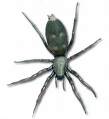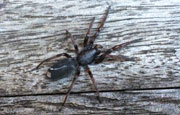
We are all generally familiar with spiders having 8 legs and usually associated with webs. However there are a hundreds of different species; some that should concern us and others that cause no harm.
Spiders are invertebrates (no skeleton) and grow by shedding their skin or cuticle. Their bodies are in 2 parts; head and abdomen. All spiders make silk and all spiders bite in order to feed. Some spiders have venom that is dangerous to man (Sydney funnel-web, Redback etc) and all spiders grow from an egg; some even carried on the back of the female. The female spider is normally larger than the male.
In domestic situations Redback spiders and Whitetails are generally regarded as harmful and whilstHuntsman spiders are large, fast and look menacing, the fact is no spider tends to bite unless provoked. Huntsman are actually very good predators of small iinsects in the home and clean up many unwanted biting insects.
At Exopest we would like to explain that a spider treatment in general these days will only effect web spinning spiders, since we are able to sight the webbing and apply pesticide directly to their harbourage and webs. Exopest do not recommend spraying for ground dwelling spiders, eg trap door spiders, wolf spiders
Unfortunately nomadic spiders such as Huntsman and Whitetails do not have webs. They hunt their prey and roam from area to area. Spiders are affected when a pesticide is absorbed through their body surface (Cuticle). Therefore when we apply residual chemicals to surfaces we cannot rely on these Nomadic spiders coming in contact with the spray unless they decide to rest down on the treated surface, which is very rare. There is no web to return to and should they not be directly sprayed during the treatment they can simply walk into the building with no ill affect. We therefore can’t guarantee spiders will not enter the building after spraying. We suggest you spray the spider directly with a surface spray; or vaccum them up or place in a container using gloves and place outside should they enter after a treatment.
Our treatment will usually involve the application of a pesticide dust to the roof void, in and around cavities of external windows and doors etc, and under the building (if access is available). Very safe synthetic pyrethroids are applied to internal skirtings and other likely harbourages. The external perimeter walls, eaves, verandahs, etc and spider webs are all also sprayed. Please leave the spider webs for a couple of weeks before removing to allow the treatment to work fully.
Clotheslines, which should be clothes free, are treated along with outbuildings and letterboxes along with any pot plants and other likely spider harbourages. It maybe necessary to vacate for up to 2-4 hours if a misting is recommended by the Exopest technician to knock down the spiders already inside.


Huntsman Spider


Whitetail Spider
The white-tailed spider is a dark, elongated spider, 1 – 2 .5 cm long with a lemon pip shape abdomen and a dull cream spot on the tip. Male spiders and juveniles often have striped legs and two or four spots at the top of the abdomen as well as one at the tip of the tail.
This spider is a common spider, which usually lives in the garden under rocks, leaf litter and the bark of trees. It does not have a permanent home, but wanders around normally at night, hunting for food, which consists of small insects and other spiders. This wandering habit, sometimes leads them into buildings or houses where they can be seen on ceilings, the floors and walls. They have been found in bundles of clothes left on the floor, washing curtain folds, bathrooms and laundries. Spiders are mostly active at night and prevalent from Spring through to late Autumn.
White-tailed Spiders are not aggressive spiders, they tend to bite only if they are provoked, threatened or startled in some way. Usually they prefer to run away. The bite can cause local burning pain followed by a variable illness.
Symptoms may include an itchy lump, swelling, discoloration, blistering, ulceration, nausea, or vomiting (Australian Animal Toxins : Dr. S. Sutherland 1983). A spider bite can lead to a bacterial infection caused by rotting foodstuffs on the fangs and there is the possibility an allergic reaction to the venom.
To treat a spider bite, the wound should be washed with soap and water, dabbed with an antiseptic solution and if painful, an ice pack or anesthetic cream/lotion applied. Try and locate the spider responsible and keep it so it can be identified correctly if necessary. Keep the person bitten under observation for 1-3 hours and if their condition deteriorates seek medical attention.
This spider is suspected of causing necrotic reaction resulting in severe skin damage in approximately twelve cases in the last 10 years. But as none of the people affected can positively identify what bit them, the White- tailed Spider remains just a suspect despite the impression most people have received from recent publicity in the newspapers and on television.
The best way to deal with these spiders inside the building or house is to use some common sense. Be aware of places they like to hide, do not leave clothes on floor or shake them thoroughly before putting them on and check bedclothes before going to bed. The spiders are more active at night so they are more likely to be seen then. Either catch the spiders and put them outside or kill them by squashing or spraying with household insecticide. It should not be necessary to employ a professional pest company to spray or fumigate your house or building solely for the control of White-tailed spiders. However, it can help reduce numbers and will kill them should they rest down onto a treated surface before entering the building.